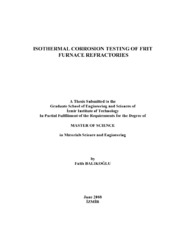Please use this identifier to cite or link to this item:
https://hdl.handle.net/11147/3196Full metadata record
| DC Field | Value | Language |
|---|---|---|
| dc.contributor.advisor | Akkurt, Sedat | en |
| dc.contributor.author | Balıkoğlu, Fatih | - |
| dc.date.accessioned | 2014-07-22T13:51:03Z | - |
| dc.date.available | 2014-07-22T13:51:03Z | - |
| dc.date.issued | 2008 | en |
| dc.identifier.uri | http://hdl.handle.net/11147/3196 | - |
| dc.description | Thesis (Master)--Izmir Institute of Technology, Materials Science and Engineering, Izmir, 2008 | en |
| dc.description | Includes bibliographical references (leaves: 92-94) | en |
| dc.description | Text in English; Abstract: Turkish and English | en |
| dc.description | xii, 94 leaves | en |
| dc.description.abstract | Results of a project aimed at understanding the corrosion behavior of aluminosilicate type of refractories in frit melts are presented. A refractory of largely andalusite and silimanite composition was compared to another brick of mullite and silimanite composition which was made by a different manufacturer for use in a different frit furnace. Density, porosity, microstructure and chemistry of both bricks are characterized before the corrosion tests. Isothermal tests were conducted by partially immersing a 15x15x115mm square specimen into a frit melt between 1404 and 1504oC in a vertical tube furnace. The frit used had an industrially used transparent frit composition. The effects of temperature, duration of exposure and refractory type were investigated using a statistically designed set of experiments. The ANOVA (Analysis of variance) table indicated that temperature and duration were more important factor effects. Increasing exposure duration and temperature both led to increased amount of corrosion as measured by the cross sectional area loss of the corroded specimen.Postmortem microstructural analysis was also done on the specimens and extensive amount of ZnO.Al2O3 precipitation was observed along the frit-refractory interface where also other crystals of mullite and alumina were found to precipitate. Increasing amount of duration and temperature produced more ZnO.Al2O3 precipitation. As identified by SEM-EDS analysis, mullite cyrstals were in the needle like morphology while alumina crystals were generally cubic. Because of their small concentration, XRD analysis could not reveal the phases of these crystals. More experiments were done by rotating the specimens in the melt at 50 rpm of rotational speed. Due to the reduction of boundary layer thickness, more dissolution was observed from the rotated specimens. In all specimens corrosion was more pronounced in the bond phase than through the large filler grains of mullite and andalusite.Keywords: Refractories, frit, corrosion, test. | en |
| dc.language.iso | en | en_US |
| dc.publisher | Izmir Institute of Technology | en |
| dc.rights | info:eu-repo/semantics/openAccess | en_US |
| dc.subject.lcc | TA418.26 B171 2008 | en |
| dc.subject.lcsh | Refractory materials--Corrosion | en |
| dc.subject.lcsh | Materials at high temperatures--Testing | en |
| dc.title | Isothermal corrosion testing of frit furnace refractories | en_US |
| dc.type | Master Thesis | en_US |
| dc.institutionauthor | Balıkoğlu, Fatih | - |
| dc.department | Thesis (Master)--İzmir Institute of Technology, Materials Science and Engineering | en_US |
| dc.relation.publicationcategory | Tez | en_US |
| item.languageiso639-1 | en | - |
| item.fulltext | With Fulltext | - |
| item.openairecristype | http://purl.org/coar/resource_type/c_18cf | - |
| item.openairetype | Master Thesis | - |
| item.grantfulltext | open | - |
| item.cerifentitytype | Publications | - |
| Appears in Collections: | Master Degree / Yüksek Lisans Tezleri | |
Files in This Item:
| File | Description | Size | Format | |
|---|---|---|---|---|
| T000704.pdf | MasterThesis | 37.9 MB | Adobe PDF |  View/Open |
CORE Recommender
Page view(s)
86
checked on Jul 22, 2024
Download(s)
198
checked on Jul 22, 2024
Google ScholarTM
Check
Items in GCRIS Repository are protected by copyright, with all rights reserved, unless otherwise indicated.